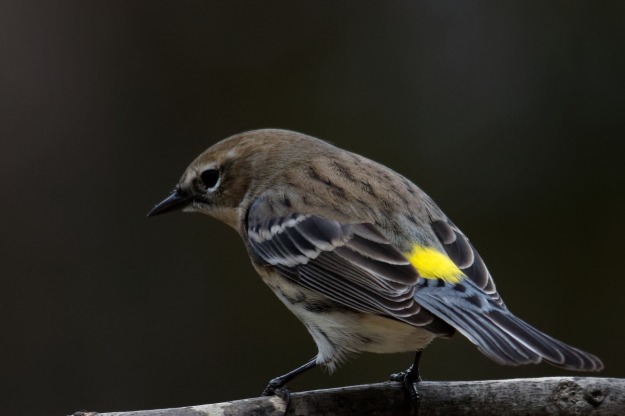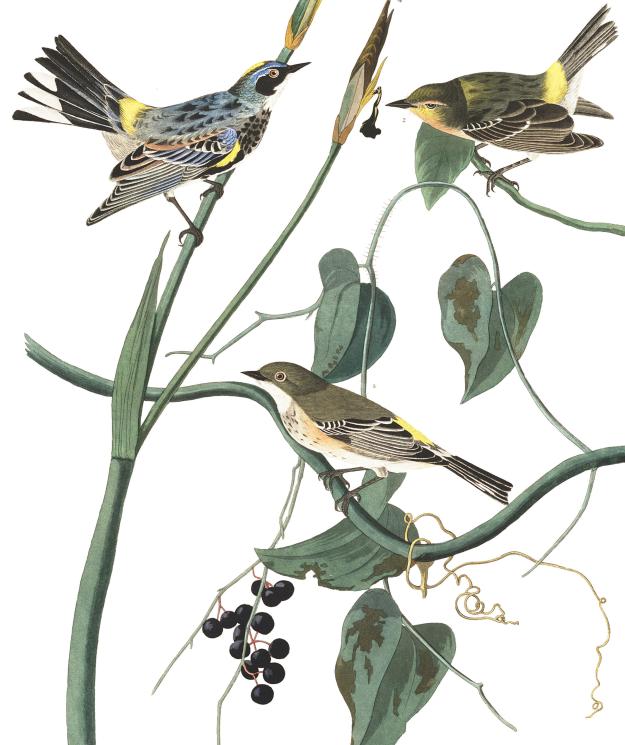
Photos by Edbo/Pixabay • The yellow-rumped warbler is abundant across North America. The species has evolved two distinct sub-species known as the “myrtle warbler” of the Eastern United States and the Audubon’s warbler of the Western United States.
Walk any woodland trails in the region and encounters with yellow-rumped warblers are likely. The linear walking trails in Erwin, walking trails at Sycamore Shoals State Historic Park in Elizabethton and the winding paths at Osceola Island Recreation Area in Bristol are almost certain to yield sightings of this wintering warbler.
A good nickname for this warbler might be “winter warbler” since most other members of the warbler family elect to spend the colder months as far south as Central and South America. From October to early May, the yellow-rumped warbler is a common bird in the region. This species also likes to form large flocks that often flit through the upper branches of trees. They are often joined by other birds, including chickadees, titmice and kinglets in mixed flocks that forage together.
Once the warmer days of summer arrive, yellow-jumped warblers have almost entirely disappeared from the region. Some of the region’s higher peaks attract this warbler during the summer, but this warbler’s population nests farther north than Northeast Tennessee, Southwest Virginia and Western North Carolina.
The yellow-rumped warbler’s appearances changes dramatically from winter to summer. By the time yellow-rumped warblers arrive each autumn, these birds are in drab brown and gray plumage, but they still display the “butter pat” yellow patch on their rump that has prompted birders to saddle this warbler with the nickname “butter butt.”
The lingering yellow-rumped warbler in late April and early May is an entirely different bird. Males have streaked backs of black on slate blue, white wing patches, a streaked breast and conspicuous yellow patches on the crown, flank and rump. Females are similar, but duller overall.
The yellow-rumped warbler ranges across North America from the Pacific to the Atlantic coast, but from the Rocky Mountains westward, the appearance of this warbler changes. Experts have gone back and forth on whether these two sub-species of yellow-rumped warbler should actually be classified as different and distinct species.
The familiar eastern bird is known as the “myrtle warbler,” but the western sub-species is named “Audubon’s warbler” in honor of the artist and early American naturalist John James Audubon. The biggest difference in the two variations is that the Aubuon’s warbler shows a yellow-throat patch compared to the white throat of the myrtle warbler. I’ve seen both. I saw the western Audubon’s warbler during a trip to Utah and Idaho in 2003.
Complicating matters is the fact that the yellow-rumped warbler also ranges into Mexico and Central America, where the appearance of the species changes yet again. Two other forms — Mexico’s black-fronted warbler and Guatemala’s Goldman’s warbler — must be added to the list.
The scientific name of the yellow-rumped warbler is Setophaga coronata. The genus setophaga is taken from ancient Greek and means “eater of moths.” As moths are incredibly abundant, yellow-rumped warblers no doubt consume some of these insects, but their diet is hardly limited to adult moths. They do eat many varieties of caterpillars, as well as beetles, weevils, ants, grasshoppers, gnats and spiders. They will also eat berries, especially during the winter months. It’s their fondness for the berries of wax-myrtle that has given this bird the name “myrtle warbler” to represent the Eastern form of the species. This bird also eats the berries of dogwood, poison ivy, Virginia creeper and dogwood.
The yellow-rumped warbler has also learned to visit feeders. Preferred foods at feeders include sunflower seeds, raisins, peanut butter and suet.
During the long months when most of the colorful, energetic warblers are absent from the region, the yellow-rumped warbler offers some solace, as well as a reminder. In a few months, area woodlands will once again explode with the songs of returning warbler. The chorus will be so vigorous that we’ll hardly notice that the yellow-rumped warbler is no longer part of the choir.
According to the website “All About Birds,” the yellow-rumped warbler is abundant. The website notes that populations of this warbler have held steady from 1966 to 2019, according to the North American Breeding Bird Survey. Partners in Flight estimates a global breeding population of 170 million individual birds.
•••
To ask a question, make a comment or share a sighting, email me at ahoodedwarbler@aol.com.






